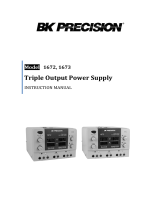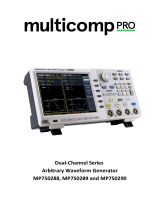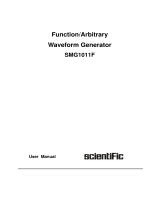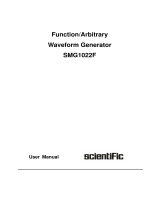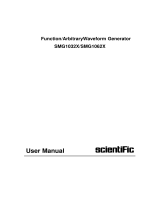Page is loading ...

Model: 4052, 4053, 4054, 4055
Function/Arbitrary Waveform
Generator
USER MANUAL

2
Safety Summary
The following safety precautions apply to both operating and maintenance personnel and must be
observed during all phases of operation, service, and repair of this instrument. Before applying power,
follow the installation instructions and become familiar with the operating instructions for this
instrument.
If this device is damaged or something is missing, contact the place of purchase immediately.
This manual contains information and warnings that must be followed to ensure safe operation as well as
maintain the meter in a safe condition.
GROUND THE INSTRUMENT
To minimize shock hazard, the instrument chassis and cabinet must be connected to an electrical ground.
This instrument is grounded through the ground conductor of the supplied, three-conductor ac power
cable. The power cable must be plugged into an approved three-conductor electrical outlet. Do not alter
the ground connection. Without the protective ground connection, all accessible conductive parts
(including control knobs) can render an electric shock. The power jack and mating plug of the power
cable must meet IEC safety standards.
DO NOT OPERATE IN AN EXPLOSIVE ATMOSPHERE
Do not operate the instrument in the presence of flammable gases or fumes. Operation of any electrical
instrument in such an environment constitutes a definite safety hazard.
KEEP AWAY FROM LIVE CIRCUITS
Instrument covers must not be removed by operating personnel. Component replacement and internal
adjustments must be made by qualified maintenance personnel. Disconnect the power cord before
removing the instrument covers and replacing components. Under certain conditions, even with the
power cable removed, dangerous voltages may exist. To avoid injuries, always disconnect power and
discharge circuits before touching them.
DO NOT SERVICE OR ADJUST ALONE
Do not attempt any internal service or adjustment unless another person, capable of rendering first aid
and resuscitation, is present.
DO NOT SUBSTITUTE PARTS OR MODIFY THE INSTRUMENT
Do not install substitute parts or perform any unauthorized modifications to this instrument. Return the
instrument to B&K Precision for service and repair to ensure that safety features are maintained.
WARNINGS AND CAUTIONS
WARNING and CAUTION statements, such as the following examples, denote a hazard and appear
throughout this manual. Follow all instructions contained in these statements.
A WARNING statement calls attention to an operating procedure, practice, or condition, which, if not
followed correctly, could result in injury or death to personnel.
A CAUTION statement calls attention to an operating procedure, practice, or condition, which, if not
followed correctly, could result in damage to or destruction of part or all of the product.

3
WARNING:
Do not alter the ground connection. Without the protective ground connection, all accessible
conductive parts (including control knobs) can render an electric shock. The power jack and mating
plug of the power cable meet IEC safety standards.
WARNING:
To avoid electrical shock hazard, disconnect power cord before removing covers. Refer servicing to
qualified personnel.
CAUTION:
Before connecting the line cord to the AC mains, check the rear panel AC line voltage indicator. Applying
a line voltage other than the indicated voltage can destroy the AC line fuses. For continued fire
protection, replace fuses only with those of the specified voltage and current ratings.
CAUTION:
This product uses components which can be damaged by electro-static discharge (ESD). To avoid
damage, be sure to follow proper procedures for handling, storing and transporting parts and
subassemblies which contain ESD-sensitive components.

4
Compliance Statements
Disposal of Old Electrical & Electronic Equipment (Applicable in the European
Union and other European countries with separate collection systems)
This product is subject to Directive 2002/96/EC of the
European
Parliament and the Council of the European Union on
waste
electrical and electronic equipment (WEEE) , and in
jurisdictions
adopting that Directive, is marked as being put on the
market after August 13, 2005, and should not be disposed
of as unsorted
municipal waste. Please utilize your local WEEE collection
facilities in the disposition of this product and otherwise
observe all applicable requirements.

5
CE Declaration of Conformity
The power supply meets the requirements of 2006/95/EC Low Voltage Directive and
2004/108/EC Electromagnetic Compatibility Directive with the following standards.
Low Voltage Directive
- EN61010-1: 2001
- EN61010-031: 2002+A1: 2008
EMC Directive
- EN 61326-1:2006
- EN 61000-3-2: 2006+A2: 2009
- EN 61000-3-3: 2008

6
Safety Symbols
Refer to the user manual for warning information to
avoid hazard or personal injury and prevent damage to
instrument.
Chassis (earth ground) symbol.
On (Power). This is the In position of the power switch
when instrument is ON.
Off (Power). This is the Out position of the power
switch when instrument is OFF.
On (Supply). This is the AC mains connect/disconnect
switch at the back of the instrument.
Off (Supply). This is the AC mains connect/disconnect
switch at the back of the instrument.
Notations
TEXT - Denotes a front panel button.
TEXT – Denotes a menu option.

7
Table of Contents
1 General Information ................................................................................ 9
1.1 Product Overview ........................................................................................................ 9
1.2 Package Contents ........................................................................................................ 9
1.3 Front Panel Overview ................................................................................................ 10
Front Panel Description .................................................................................................... 10
1.4 Rear Panel Overview ................................................................................................. 11
Rear Panel Description ..................................................................................................... 11
1.5 Display Overview ....................................................................................................... 12
Display Description ........................................................................................................... 12
2 Getting Started ...................................................................................... 12
2.1 Input Power Requirements ....................................................................................... 12
Input Power ...................................................................................................................... 12
2.2 Output Connections .................................................................................................. 13
Impedance Matching ....................................................................................................... 13
2.3 Preliminary Check ...................................................................................................... 14
Check Model and Firmware Version ................................................................................ 16
Output Check .................................................................................................................... 16
3 Front Panel Operation ........................................................................... 17
3.1 Menu Options ............................................................................................................ 17
3.2 Selecting a Channel ................................................................................................... 20
3.3 Configure Waveform Output ..................................................................................... 20
Configure Waveform Shape ............................................................................................. 20
Configure Frequency ........................................................................................................ 22
Configure Amplitude ........................................................................................................ 22
Configure DC Offset .......................................................................................................... 24
Configure Phase ............................................................................................................... 24
Configure Duty Cycle and Symmetry ................................................................................ 25
Configure Pulse Waveform ............................................................................................... 27
Configure Noise Waveform .............................................................................................. 29
Configure Arbitrary Waveform ........................................................................................ 30
Configure DC Output ........................................................................................................ 33
3.4 Configure Modulation ............................................................................................... 34
AM Modulation ................................................................................................................ 34

8
DSB-AM ............................................................................................................................ 35
ASK (Amplitude Shift Keying) ........................................................................................... 37
FM Modulation ................................................................................................................ 38
FSK (Frequency Shift Keying) ............................................................................................ 39
PM Modulation ................................................................................................................ 40
PWM Modulation ............................................................................................................. 41
3.5 Configure Sweep Output ........................................................................................... 43
3.6 Configure Burst .......................................................................................................... 46
3.7 Store and Recall ......................................................................................................... 49
Accessing Store/Recall Menu ........................................................................................... 50
Store and Recall Instrument State .................................................................................... 51
Store and Recall Arbitrary Waveforms ............................................................................. 53
3.8 Utility Functions ........................................................................................................ 55
DC Waveform Output ....................................................................................................... 55
Remote Interface .............................................................................................................. 56
Output Configurations ..................................................................................................... 57
Frequency Counter ........................................................................................................... 60
3.9 System Configurations ............................................................................................... 62
System Settings ................................................................................................................ 63
Self Test and Adjustment .................................................................................................. 67
Check Instrument Information ......................................................................................... 67
Updating Firmware .......................................................................................................... 67
3.10 Help System ........................................................................................................... 68
4 Troubleshooting Guide .......................................................................... 69
5 Specifications ........................................................................................ 70
SERVICE INFORMATION ................................................................................ 75
LIMITED ONE-YEAR WARRANTY ................................................................... 76

9
1 General Information
1.1 Product Overview
The B&K Precision 4050 series are dual channel function / arbitrary waveform generators,
capable of generating up to 50 MHz sine wave (model 4055). They have an informative easy-
to-read color display, user-friendly controls and a numeric keypad which allows users to
easily configure waveform properties. In addition, they feature non-volatile built-in
memory to create, store, and recall arbitrary waveforms up to 16,000 points with 14-bit
vertical resolution. 48 predefined arbitrary waveforms are also available for output. A
standard USB interface on the rear panel allows users to easily interface with application
software to create and load arbitrary waveforms into the instrument.
Features:
Generate sine wave from 1 µHz up to 50 MHz (4055)
3.5-inch TFT-LCD color display
USB interface
16k pts arbitrary waveform memory
48 built-in predefined arbitrary waveforms
Store/recall up to 10 instrument settings
1.2 Package Contents
Please inspect the instrument mechanically and electrically upon receiving it. Unpack all
items from the shipping carton, and check for any obvious signs of physical damage that may
have occurred during transportation. Report any damage to the shipping agent immediately.
Save the original packing carton for possible future reshipment. Every instrument is shipped
with the following contents:
4050 series function/arbitrary waveform generator
Getting started manual (printed)
Full instruction manual on CD
AC power cord
USB type A to Type B cable
Certificate of calibration
Verify that all items above are included in the shipping container. If anything is missing,
please contact B&K Precision.
An optional USB to GPIB adapter model AK40G is also available

10
1.3 Front Panel Overview
Front Panel Description
Power On/Off switch
TFT LCD color display
Menu function keys
Waveform buttons
Modulation/Sweep/Burst/Store-Recall/Utility/Help menu buttons
Channel 2 output BNC / Counter input
Channel 1 output BNC
Channel 1 and 2 output On/Off buttons
Arrow keys
Rotary dial knob
Numeric keypad
Channel selection button
USB host port / *USB-to-GPIB adapter interface
Accepts USB flash drive to save/recall instrument settings and waveforms.
*This port can be used for connecting the USB-to-GPIB adapter (AK40G)
accessory. It can also be used for connecting an external USB flash drive.
1
2
3
4
5
6
7
8
9
10
11
12
13
1
2
3
4
5
6
7
8
12
13
9
10
11

11
1.4 Rear Panel Overview
Rear Panel Description
Modulation Input BNC
External Trigger/Gate/FSK/Burst BNC Connector
USB interface
AC input receptacle
Chassis ground
Sync Output BNC
Trigger Input BNC
1
2
3
4
6
7
5
1
2
3
4
5
6
7

12
1.5 Display Overview
Display Description
Waveform information display
Waveform parameters display
Menu options
Output impedance indicator
Selected channel indicator tab
2 Getting Started
Before connecting and powering up the instrument, please review and go through the
instructions in this chapter.
2.1 Input Power Requirements
Input Power
The supply has a universal AC input that accepts line voltage and frequency input within:
100 – 240 V (+/- 10%), 50 – 60 Hz (+/- 5%)
100 – 127 V , 45 – 440 Hz
1
2
3
4
5
1
2
3
4
5

13
Before connecting to an AC outlet or external power source, be sure that the power switch is
in the OFF position and verify that the AC power cord, including the extension line, is
compatible with the rated voltage/current and that there is sufficient circuit capacity for the
power supply. Once verified, connect the cable firmly.
WARNING:
The included AC power cord is safety certified for this
instrument operating in rated range. To change a
cable or add an extension cable, be sure that it can
meet the required power ratings for this instrument.
Any misuse with wrong or unsafe cables will void the
warranty.
2.2 Output Connections
The waveform generator output circuits operate as a 50 Ω voltage source working into a 50
Ω load. At higher frequencies, a non-terminated or improperly terminated output may cause
aberrations on the output waveform. In addition, loads with an impedance less than 50 Ω
will reduce the waveform amplitude, while loads with an impedance greater than 50 Ω will
increase waveform amplitude.
Excessive distortion or aberrations caused by improper termination are less noticeable at
lower frequencies, especially with sine and triangle waveforms. To ensure waveform
integrity, follow these precautions:
1. Use good quality 50 Ω coaxial cable and connectors.
2. Make all connections tight and as short as possible.
3. Use good quality attenuators, if it is necessary to reduce waveform amplitudes
applied to sensitive circuits.
4. Use termination or impedance-matching devices to avoid reflections.
5. Ensure that attenuators and terminations have adequate power handling
capabilities.
If there is a DC voltage across the output load, use a coupling capacitor in series with the
load. The time constant of the coupling capacitor and load must be long enough to maintain
pulse flatness.
Impedance Matching
If the waveform generator is driving a high impedance, such as a 1 MΩ input impedance
(paralleled by a stated capacitance) of an oscilloscope vertical input, connect the
transmission line to a 50 Ω attenuator, a 50 Ω termination and to the oscilloscope input. The
attenuator isolates the input capacitance of the device and terminates the waveform
generator properly.

14
2.3 Preliminary Check
Complete the following steps to verify that the generator is ready for use.
1. Verify AC Input Voltage
Verify and check to make sure proper AC voltages are available to power the
instrument. The AC voltage range must meet the acceptable specification as
explained in section 2.1.
2. Connect Power
Connect AC power cord to the AC receptacle in the rear panel and press the power
switch to the ON position to turn ON the instrument. The instrument will have a
boot screen while loading, after which the main screen will be displayed.
3. Self Test
Press Utility, select 1/2 from the menu to enter the second menu page, and select
Test/Cal option. Then, select SelfTest option. The instrument has 3 self test options
to test the screen, keys, and the LED back lights of the function, menu, and channel
output keys.
ScrTest
Select this option to do a screen test. The screen will turn into a solid
color background.

15
Press 7 to toggle through red, green, and blue colors. This test checks
for dead pixels and color consistencies of the TFT LCD display. Press 8 to
exit the test.
KeyTest
Select this option to do a key test. The screen will display a silhouette of
buttons that represent the front panel buttons.
Press any of the front panel buttons and its corresponding button in the
silhouette will turn green. This tests the key press response. If any of
the buttons do not change colors on the silhouette when pressed, there
may be something faulty with the key. Press 8 three times to exit the
test.
LEDTest
Select this option to test the function, menu, and channel output
buttons’ backlight.
Like the key test, the screen will display a silhouette of buttons that
represent the front panel buttons. Press 7 to begin the test. This test
will start with the Sine button, which should light up. Its corresponding
button in the silhouette should also turn green. Continue to press 7 to
toggle through all the buttons with backlights available. At the end of
the test, all function, menu, and channel output buttons will light up,
and all of their corresponding buttons in the silhouette on the display
will turn green. Press 8 to exit the test.

16
4. Self Adjust
This option runs an internal self adjustment procedure that will check and adjust the
instrument to specification. Use this option only if the instrument is suspected to be
out of calibration.
Press Utility, select 1/2 from the menu to enter the second menu page, and select
Test/Cal option. Then, select SelfAdjust option. The instrument will run the
procedure internally, and a progress bar will be displayed in the waveform
information area. When finished, it will show 100% on the progress bar and prompt
you to press any function key to continue. Follow the prompt to return to the main
display.
Check Model and Firmware Version
The model and firmware version can be verified from within the menu system.
Press Utility, select 1/2 from the menu to enter the second menu page, and select EditInfo
option. The software/firmware version, hardware version, model, and serial number will be
displayed. Press any function key to exit.
Output Check
Follow the steps below to do a quick check of the settings and waveform output.
1. Turn on the instrument and set the instrument to default settings. To set to default,
press Utility, press 1/2 to go to page 2, select System from the menu, and select Set
to Default. The instrument will set both channels with the following parameters:
Waveform Shape: Sine
Frequency: 1.000000 kHz
Amplitude: 4.000 Vpp
Offset: 0.0 mVdc
Phase: 0.0 °

17
Output Impedance: Hi-Z
2. Connect the BNC output of CH1 (yellow) into an oscilloscope.
3. Press the Output button on top of CH1 output BNC to turn on the output and
observe a sine wave with the parameters above.
4. Press the Freq or Period option in the menu and use the rotary knob or the numeric
keypad to change frequency. Observe the changes on the oscilloscope display.
5. Press the Ampl option in the menu and use the rotary knob or the numeric keypad
to change the amplitude. Observe the changes on the oscilloscope display.
6. Press the Offset option in the menu and use the rotary knob or the numeric keypad
to change the DC offset. With the oscilloscope set for DC coupling, observe the
changes on the display.
7. Now, connect the BNC output of CH2 (blue) into an oscilloscope and follow steps 3
to 6 to check its output.
3 Front Panel Operation
3.1 Menu Options
All settings and parameters can be configured from the menu system of the instrument. The
menu options that are channel specific are the same for both channel 1 and channel 2. Use
the key to toggle the channel selection.
Some many options are grouped in pairs and can be selected by toggling their corresponding
menu function keys. For example:
Function key will toggle selection between frequency or period.
Function key will toggle selection between amplitude or HI level.
Function key will toggle selection between DC offset or LO level.
Function key will toggle selection between phase or equal phase.
Function key will go to page 2/2 menu.
The menu system is organized as follows:
Sine
Freq/Period
Configures the frequency or period of the waveform.
Ampl/HLevel
Configures the amplitude or the high level of the waveform.
Offset/LLevel
Configures the DC offset or the low level of the waveform.
CH1/2

18
Phase/EqPhase
Configures the phase or set equal phase relative to the other
channel.
Square
Freq/Period
Configures the frequency or period of the waveform.
Ampl/HLevel
Configures the amplitude or the high level of the waveform.
Offset/LLevel
Configures the DC offset or the low level of the waveform.
Phase/EqPhase
Configures the phase or set equal phase relative to the other
channel.
Duty
Configures the duty cycle of the waveform.
Ramp
Freq/Period
Configures the frequency or period of the waveform.
Ampl/HLevel
Configures the amplitude or the high level of the waveform.
Offset/LLevel
Configures the DC offset or the low level of the waveform.
Phase/EqPhase
Configures the phase or set equal phase relative to the other
channel.
Symmetry
Configures the symmetry of the waveform.
Pulse
Freq/Period
Configures the frequency or period of the waveform.
Ampl/HLevel
Configures the amplitude or the high level of the waveform.
Offset/LLevel
Configures the DC offset or the low level of the waveform.
PulWidth/Duty
Configures the pulse width or the duty cycle of the pulse.
Delay
Configures the delay of the pulse waveform.
Noise
Stdev
Configures the standard deviation of the noise waveform.
Mean
Configures the mean value of the noise waveform.
Arb
Freq/Period
Configures the frequency or period of the waveform.
Ampl/HLevel
Configures the amplitude or the high level of the waveform.
Offset/LLevel
Configures the DC offset or the low level of the waveform.
Phase/EqPhase
Configures the phase or set equal phase relative to the other
channel.
Load Wforms
Built-In – Access selectable built-in waveforms for output.
Stored Wforms – Access arbitrary waveforms stored in
internal memory for output.
Mod
AM Freq/AM
Depth/DSB
Freq/Key
Freq/FM
Freq/FM
Dev/PM
Freq/Phase
Dev/PWM
Freq/Width
Dev
Configures parameters for AM, FM, PM, ASK, FSK, DSB-
AM,PWM modulation.
Type
Configures the type of modulation.
Shape
Configures the modulating waveform shape.
Source
Selects modulating source.
Sweep

19
SwpTime
Configures the sweep time for sweep output.
StopFreq/FrqSp
an
Configures the sweep stop frequency or the frequency span of
the sweep output.
StartFreq/MidF
req
Configures the sweep start frequency or the center frequency.
Source
Selects the sweep source.
Trig Out/Edge
Internal source: Selects to output a trigger signal at the start
of a sweep operation.
External source: Selects to use rising or falling edge from an
external trigger for sweep operation.
Linear/Log
Selects between linear or logarithmic sweep operation.
Direction
Selects the sweep direction
Trig
Manually triggers the sweep operation if the source is set to
manual.
Burst
Period
Configures the burst period.
StartPhase
Configures the start phase of the burst output.
Ncycle/Gated
Selects to burst by number of cycles or selects for external
gated burst.
Source/Polarity
Selects the source for burst output or selects the polarity for
external gated burst output.
Trig Out
Selects signal triggering on rising or falling edge.
Cycles/Infinite
Configures number of cycles for burst or infinite burst
(external source only).
Delay
Configures the delay of each burst.
Store/Recall
FileType
Selects the type of files for save/recall.
Browser
Selects to browser through folders or files on display.
Save
Saves the selected file into internal or external USB flash
memory.
Recall
Recalls the selected file from internal or external USB flash
memory.
Delete
Select to delete the selection.
Utility
DC
Selects to toggle ON/OFF a DC output. Selectable DC voltages
are: 1 V, -1 V, 2 V, -2 V, 5 V, -5 V.
Interface
Selects the remote interface. .
Output Setup
Load – Select output impedance.
Normal/Invert – Select to toggle between normal and
inverted output.
CHCopy – Copy channel settings between channels.
Sync – Select to enable/disable synchronization output with
respect to either channel 1 or 2.
Counter
Selects built-in counter function.
System
Access to system settings.
Test/Cal
Built-in self test and adjustment options.
EditInfo
Shows information about the generator.
Update
For firmware updates.

20
Help
3.2 Selecting a Channel
The 4050 series function/arbitrary waveform generators have dual channel outputs. They
can be operated independently or in sync with each other. To select between channel 1 and
2 and view/change their parameters, toggle the key.
When Channel 1 is selected, the display will look like below:
When Channel 2 is selected, the display will look like below:
3.3 Configure Waveform Output
Configure Waveform Shape
The instrument can generate many standard as well as arbitrary waveforms. There are
waveform keys on the front panel that will switch between different waveform shape to
output. Below is a table of waveforms and the corresponding keys to press to generate
those waveforms.
CH1/2
/
